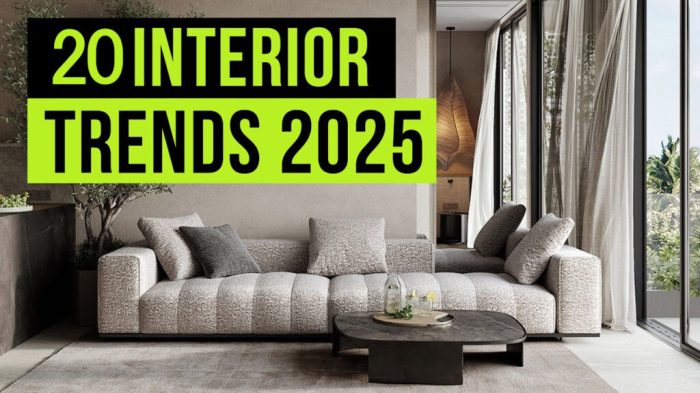As Luxury interior trends dominating 2025 takes center stage, this opening passage beckons readers into a world crafted with good knowledge, ensuring a reading experience that is both absorbing and distinctly original. From design innovations to sustainable practices, the landscape of luxury interiors is set to undergo a remarkable transformation.
Delve into the upcoming trends that will redefine luxury living and explore the fusion of elegance with technological advancements, setting the tone for a new era in interior design.
Design Trends
Luxury interior design trends expected to dominate in 2025 are characterized by a fusion of modern innovation and timeless elegance. These trends focus on creating spaces that are not only visually stunning but also functional and sustainable.
Key Elements of Luxury Interior Design
- High-quality Materials: Luxury interior design often incorporates premium materials such as marble, brass, and exotic woods to add an element of opulence.
- Customization: Personalization is key in luxury design, with bespoke furniture and unique pieces tailored to the client's preferences.
- Attention to Detail: Intricate details, from ornate moldings to handcrafted finishes, elevate the overall look of luxury interiors.
- Integration of Technology: Smart home systems and cutting-edge gadgets seamlessly blend into the design, offering both convenience and sophistication.
Sustainability in Luxury Interior Design Trends
As sustainability continues to be a growing concern, luxury interior design trends in 2025 are embracing eco-friendly practices and materials. Designers are incorporating elements like recycled wood, energy-efficient lighting, and organic textiles to reduce the environmental impact of their projects.
The focus is on creating luxurious spaces that are not only beautiful but also sustainable for the future.
Material Selection
When it comes to luxury interior design in 2025, the selection of materials plays a crucial role in defining the overall look and feel of a space. Designers are constantly exploring new ways to integrate both traditional luxury materials and modern sustainable alternatives to create unique and eco-friendly interiors.
Popular Materials in Luxury Interior Design
- Marble: Known for its elegance and timeless appeal, marble continues to be a popular choice for luxury interiors. Its natural veining and variety of colors make it a versatile option for surfaces like countertops and flooring.
- Brass: Brass accents add a touch of luxury and sophistication to any space. From light fixtures to hardware, brass is a favorite material for adding a warm and inviting feel to interiors.
- Velvet: Luxurious and soft, velvet upholstery is a staple in luxury interior design. Its rich texture and deep colors bring a sense of opulence to furniture pieces and accessories.
Advancements in Material Technology
With advancements in material technology, designers are now able to explore innovative options that combine luxury with sustainability. Modern sustainable materials such as recycled glass, reclaimed wood, and eco-friendly fabrics are gaining popularity for their eco-conscious properties without compromising on style.
Color Palette

In luxury interior design, the color palette plays a crucial role in creating a sophisticated and elegant atmosphere. The colors chosen can significantly impact the overall look and feel of a space, influencing the mood and style it conveys. Let's delve into the color palettes predicted to dominate luxury interiors in 2025 and explore the psychology behind color selection in this context.
Prominent Color Palettes
- Neutral Elegance: Shades of white, cream, beige, and gray are expected to continue to be popular choices for luxury interiors in 2025. These neutral tones create a sense of calmness, sophistication, and timelessness.
- Jewel Tones: Rich and vibrant colors like emerald green, sapphire blue, and amethyst purple are forecasted to make a statement in luxury interior design. These colors add opulence, drama, and a touch of luxury to the space.
- Earthy Warmth: Terracotta, rust, ochre, and other warm earthy tones are predicted to be embraced in luxury interiors for their connection to nature and ability to create a cozy and inviting atmosphere.
Psychology of Color Selection
Color psychology plays a significant role in luxury interior design, as different colors can evoke specific emotions and energies. For example, cool tones like blues and greens are known for their calming and serene properties, making them ideal for bedrooms or relaxation areas.
On the other hand, warm tones like reds and oranges can create a sense of warmth, energy, and intimacy, perfect for social spaces like dining rooms or living areas.
Moods and Atmospheres
The color scheme chosen for a luxury interior can set the tone for the entire space. A monochromatic color scheme can create a sense of harmony and unity, while contrasting colors can add excitement and visual interest. By strategically using color, interior designers can manipulate the mood and atmosphere of a room, whether aiming for a cozy, intimate setting or a grand, luxurious ambiance.
Smart Home Integration

Incorporating smart home technology into luxury interior design has revolutionized the way we interact with our living spaces. From automated lighting to climate control systems, smart features enhance both functionality and aesthetics in luxury homes.
Voice-activated Assistants
Voice-activated assistants like Amazon's Alexa or Google Home have become a staple in luxury homes, allowing residents to control various aspects of their environment with simple voice commands. From adjusting lighting and temperature to playing music or setting reminders, these assistants offer convenience and seamless integration with other smart devices.
Automated Window Treatments
Automated window treatments, such as motorized blinds or smart curtains, not only provide privacy and light control but also contribute to the overall ambiance of a luxury interior. These features can be programmed to open or close at specific times of the day, enhancing energy efficiency and adding a touch of sophistication to the space.
Smart Appliances
Smart appliances, like refrigerators with built-in cameras or ovens with remote control capabilities, bring a new level of convenience and efficiency to luxury kitchens. These high-tech devices not only streamline daily tasks but also add a modern flair to the interior design, blending seamlessly with the overall aesthetic.
Epilogue
In conclusion, Luxury interior trends dominating 2025 promise an exciting journey into a realm where aesthetics meet functionality in perfect harmony. With a focus on sustainability, cutting-edge materials, captivating color palettes, and smart home integration, the future of luxury interiors is bright and full of possibilities.
Stay ahead of the curve and embrace the opulence and innovation that define the essence of luxury living in 2025.
Common Queries
What are the key elements that define luxury interior design?
The key elements of luxury interior design include high-quality materials, attention to detail, elegant furnishings, and a focus on creating a sophisticated and inviting atmosphere.
How is sustainability influencing luxury interior design trends?
Sustainability is shaping luxury interior design trends by promoting the use of eco-friendly materials, energy-efficient technologies, and a focus on creating spaces that are environmentally responsible.
What are the most popular materials used in luxury interior design for 2025?
Popular materials in luxury interior design for 2025 include sustainable wood, recycled glass, natural stone, and innovative composites that offer both durability and aesthetic appeal.
How do different color schemes evoke various moods in luxury settings?
Color schemes play a crucial role in setting the mood in luxury interiors. Warm tones like gold and burgundy evoke luxury and opulence, while cooler tones like blues and greens create a sense of tranquility and sophistication.
What impact do smart home features have on the functionality and aesthetics of luxury interiors?
Smart home features enhance the functionality and aesthetics of luxury interiors by offering convenience, security, and efficiency. From automated lighting to integrated entertainment systems, these technologies elevate the luxury living experience.






